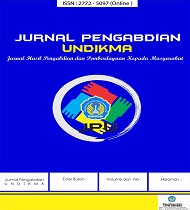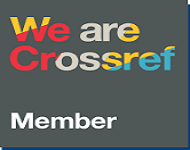Locality vs Globality: Wayang Sasak's Practice and Teaching in the World Literature
DOI:
https://doi.org/10.33394/jk.v8i4.5834Keywords:
Literature, Puppets, Sasak, Practice, Teaching, Sociology, Ethnography.Abstract
This research aims to examine the issue of the relationship between locality and globality which is the practice of Sasak puppets in teaching global literary values. The research was conducted on the work on the play Brambang Ulung, one of Amir Hamzah's series of stories in the Sasak puppet. The method combines ethnographic studies, video recordings, literature reviews and interviews. Processing the data using the movie avi 15 plus and excel. This research applies discourse analysis and representation of the Bourdieusian model. Data analysis showed that the field practice lasted all night around 6:56:21 (six hours and fifty-six minutes and twenty-one seconds, divided into preparation, 0.27:20 or 6.75%; modal gending with a duration of 1:30:47 or 21.80%; and the play modal with a duration 4:58:18 or 71.63%. The analysis of the play modal with a duration of 4:58:18, found the main play modal is in Middle Javanese language, 2:35:51 or 52.26%; the intermediate play modal is in Middle Javanese and Sasak language, with time duration 0:52:40 or 17.66%; and Sasak language play modal with a duration of 1:29:43 or 30.08%. This study reveals the global (Arabic) literary value of Amir Hamzah's story, including da'wah. This practice is a legacy of local teaching networks and pre-modern global. Ricci termed this network with Arab Kosmopolis, a literary network that forms a network of ummah. Pre-modern models of local and global relations, such as in the field practice of Sasak puppets, appear grounded. This is different from the model in local textbooks, wayang Sasak and other local contexts are taught as complementary.
References
Boonstra, Sadiah Nynke. (2014). “Changing Wayang Scenes Heritage Formation and Wayang Performance Practice in Colonial and Postcolonial Indonesia.†de Vrije Universiteit Amsterdam.
Bordieu, P. (1977). Outline of a Theory of Practice, trans. R. Nice (Cambridge, 1977). Boswell, John. The Royal Treasure: Muslim Communities under the Crown of Aragon in.
Bourdieu, P. (1993). Arena Produksi Kultural, Sebuah Kajian Sosiologi Budaya, trans. Yudi Santoso (Kreasi Wacana, 2012). Kreasi Wacana, Bantul.
Bourdieu, P. (1996). The Rules of Art: Genesis and Structure of the Literary Field. 1992. Trans. Susan Emanuel. Stanford: Stanford UP.
Clara van Groenendael, V. M. (1992). “Is There an Eastern Wayang Tradition? Some Dramatis Personae of the Murwakala Myth of the ‘Eastern’ Tradition.†Bijdragen Tot de Taal-, Land- En Volkenkunde / Journal of the Humanities and Social Sciences of Southeast Asia 148(2):309–15. doi: 10.1163/22134379-90003158.
Damanik, Erond Litno. (2018). “Rekayasa Budaya dan Dinamika Sosial : Menemukan Pokok Pikiran Lokalitas Budaya Sebagai Daya Cipta.†1(2):93–103.
Diah, Naomi, and Budi Setyaningrum. (2018). “Budaya Lokal Di Era Global.†Jurnal Ilmu Pengatahuan Dan Karya Seni 1662(20):2.
Eastwood, Jonathan. (2019). “Bourdieu , Flaubert , and the Sociology of Literature Author (s): Jonathan Eastwood Published by : American Sociological Association. Stable URL : Https://Www.Jstor.Org/Stable/20453073 American Sociological Association Is Collaborating with JSTOR to Digi.†25(2):149–69.
Harnish, David. (2003). “Worlds of Wayang Sasak: Music, Performance, and Negotiations of Religion and Modernity.†Asian Music 34(2):90–120. doi: 10.2307/4098458.
Jeanette DeBouzek. (1986). “Mysticism as Defense in Javanese Shadow-Play Theater: The Story of ‘Dewa Ruci.’†American Imago 43(4):273–88.
Kartomi, Margaret. (2010). “Meaning , Style and Change in Gamalan and Wayang Kulit Banjar Since Their Transplantation from Hindu-Buddhist Java to South Kalimantan.†52(1):476–514.
Kayam, Umar. (2001). Kelir Tanpa Batas. Yogyakarta: Gama Media.
Mukhibat. (2015). “Meneguhkan Kembali Budaya Pesantren Dalam Merajut Lokalitas, Nasionalitas, Dan Globalitas.†23(156):177–92. doi: 10.19105/karsa.v2312.717.
Nugroho, Sugeng, Sunardi, and I. Nyoman Murtana. (2018). “Garap Pertunjukan Wayang Kulit Jawa Timuran.†Acintya, Jurnal Penelitian Seni Budaya 10(2):149–58.
Petersen, R. (2001). Lakon Karangan: The Legacy of Ki Nartosabdho in Banyumas, Central Java. Asian Theatre Journal, 18(1), 105–112. https://doi.org/10.1353/atj.2001.0007
Pollock, Sheldon (2009). The Language of Gods in the Word of Men, Sanskrit, Culture, and Power in Premodern India. University of California Press. USA.
Qodri, Muh. Syahrul. (2018). “Kesempurnaan Wong Menak Dalam Wayang Sasak.†Panggung 28(3). doi: 10.26742/panggung.v28i3.471.
Ricci, Ronit. (2013). Islam Translated: Literature, Conversasion, and the Arabic Cosmopolis of South and Southeast Asia. Chicago and London: The University of Chicago Press.
Sedana, I. Nyoman. (2002). “Kawi Dalang: Creativity in Wayang Theatre.†The University of Georgia.
Sedana, I. Nyoman. (2005). “Collaborative Music in the Performance of the Balinese Shadow Theater.†Asian Music 36(1):44–59.
Subandi. (2005). “Lakon Anoman Duta Garap Padat : Sebuah Penelitian Singkat.†Harmonia: Jurnal Pengetahuan Dan Pemikiran Seni VI(3).
Sudarsono. (2012). “Garap Lakon Kresna Dhuta Dalam Pertunjukan Wayang Kulit Purw Gaya Surakarta, Kajian Tektual Simbolis.†Harmonia 12(1):75–86.
Wahid, Abdurrahman. (2007). Islam Kosmopolitan, Nilai-nilai Indonesia dan Transformasi Kebudayaan. The Wahid Institute, Seeding Plural and Peaceful Islam. Jakarta.
Weintraub, Andrew N. (2001). “Contest-Ing Culture: Sundanese Wayang Golek Purwa Competitions in New Order Indonesia.†Asian Theatre Journal 18(1):87–104. doi: 10.1353/atj.2001.0011.
Downloads
Published
How to Cite
Issue
Section
Citation Check
License
License and Publishing Agreement
In submitting the manuscript to the journal, the authors certify that:
- They are authorized by their co-authors to enter into these arrangements.
- The work described has not been formally published before, except in the form of an abstract or as part of a published lecture, review, thesis, or overlay journal.
- That it is not under consideration for publication elsewhere,
- That its publication has been approved by all the author(s) and by the responsible authorities tacitly or explicitly of the institutes where the work has been carried out.
- They secure the right to reproduce any material that has already been published or copyrighted elsewhere.
- They agree to the following license and publishing agreement.
Copyright
Authors who publish with JK agree to the following terms:
- Authors retain copyright and grant the journal right of first publication with the work simultaneously licensed under a Creative Commons Attribution License (CC BY-SA 4.0) that allows others to share the work with an acknowledgment of the work's authorship and initial publication in this journal.
- Authors are able to enter into separate, additional contractual arrangements for the non-exclusive distribution of the journal's published version of the work (e.g., post it to an institutional repository or publish it in a book), with an acknowledgment of its initial publication in this journal.
- Authors are permitted and encouraged to post their work online (e.g., in institutional repositories or on their website) prior to and during the submission process, as it can lead to productive exchanges, as well as earlier and greater citation of published work.
Licensing for Data Publication
-
Open Data Commons Attribution License, http://www.opendatacommons.org/licenses/by/1.0/ (default)

This work is licensed under a Creative Commons Attribution-ShareAlike 4.0 International License.







